| s/y Nine of Cups Trinidad 2002 |
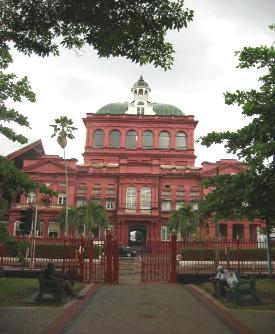
| Trinidad is the southernmost island in the Caribbean chain. Only 7 miles from the Venezuelan coast, it is geologically part of South America. |
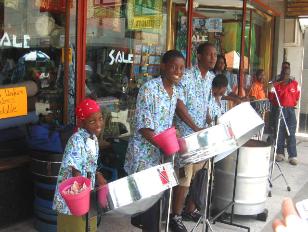
| Steel pan music was invented on Trinidad. When British authorities banned African drumming, the people made music from bamboo, thumped on the ground and reinforced with improvised percsussion. During the 1930's and 1940's, this percussion - discarded biscuit tins and empty oil drums - became a new sort of drum, the steel drum. Each note is tuned by hammering a dent into the surface of the steel. Today's steelbands perform everything from western classics to calyso and you can hear the music everywhere and all the time. Trinidad is also the home of the “limbo” and the calypso. |
| We took a bus into Port-of-Spain, the capital of Trinidad and the trade center of Trinidad/Tobago, was founded in 1560 by Spanish colonists. It's the largest city we've seen since leaving Puerto Rico. It is crowded and the traffic is heavy...like most large cities. We enjoyed exploring the streets and neighborhoods. Charlotte Street, for instance, has lots of shops selling housewares, as well as an Asian section, where the shops sell everything from dried mushrooms to crystallized ginger. The Red House, pictured above, is Trinidad's House of Parliament. |
| Finally, on to Trinidad! The island to island trip from Tobago to Trinidad is only about 25 miles, but it’s necessary to traverse the entire length of the island to get to the marina in Chaguaramas…another 50 miles. We decided to anchor in Grand Riviere, a small fishing village on the north coast only about 30 miles way, then complete the trip to the marina the next day. We have mixed emotions about reaching Trinidad. It’s the end of a long passage and we get to stay in a marina…hooray. But then it’s the “end” of a passage and we have to stay in a marina…crowded, hot, no breezes, no sailing for the next 2-3 months. |
| We have not been in a marina since Riding Rock in San Salvador in the Bahamas and they didn’t offer electricity or water at the dock. Power Boats is the largest boatyard in Chaguaramas and is primarily noted for boat work and storing boats out of the water “on the hard”. There are, however, a few slips available for transients (that’s what we are, “foreign transients”) who wish to stay in the water. Daily rates are about 1/5 of what we paid for similar services in the States. |
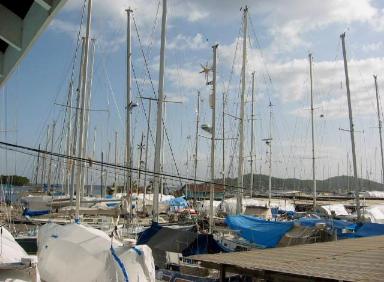
| Power Boats Marina...hot, crowded and breeze-less. |
| We officially arrived in Trinidad on July 31st and helped celebrate Emancipation Day on August 1st. A public holiday, Emancipation Day, celebrates the abolition of slavery in 1834. There are parades and festivities throughout the island. The staff at the restaurant at our marina, “Sails”, dressed in traditional dress and a pan band provided live entertainment. |
| The population of Trinidad is different than that of Tobago which is primarily black. Because of Indian indentured immigration in the mid-1800’s after the abolition of slavery in 1834, there is a huge Indian population (40%) in Trinidad. The population also traces its roots to Africa (40%), China, the Middle East, Europe and the Mediterranean. Almost 30% are Roman Catholic, about 25% are Hindu, just over 10% are Anglican and 6% are Muslim. Quite a melting pot! Above, a common sight was a Hindu temple. |
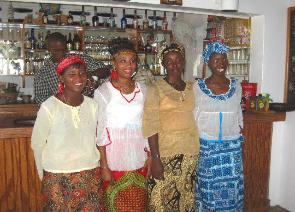
| Inhabitants of Trinidad are called Trinis. |
| Trinidad is home to two species of monkeys: capuchins and howlers. Two capuchin pets live on a boat in the marina and we had the chance to meet them. Calvin the Obnoxious pictured above with David is very mischievous and has managed to untie his owner’s dock lines on several occasions setting their boat adrift. |
| One of the main natural attractions on Trinidad is the Caroni Swamp. It is a huge protected area and bird sanctuary, home of Trinidad's nationa bird, the scarlet ibis and about 170 other species of birds and indigenous animals including tree snakes (boas), raccoons, possum and hairy crabs. Our trip netted us only a blurry scarlet ibis shot. |
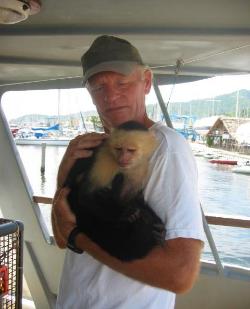
| Trinidad was claimed by Christopher Columbus for Spain in 1498. |
| Trinidad & Tobago are home to over 430 species of birds, 620 different species of butterflies (including the Blue Emperor), 2,300 different flowering shrubs and plants (700 of which are orchids). There are 108 different mammals including 57 bats and 70 different reptiles. Oilbirds, only found here and northern South America, live in caves and maneuver by sonar like bats. There are fish-eating bats and vampire bats, anacondas, giant leatherback turtles, capuchin and howler monkeys, sightless fish, a unique golden tree frog and an almost extinct bush turkey. |
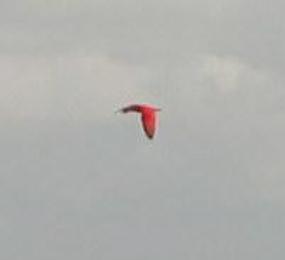
| Of all the places we visited in Trinidad, the one that exceeded all expectation was the Asa Wright Nature Centre. Nestled in the hills of the Arima Valley, we traveled about 1½ hours by van to reach this 193-acre nature preserve. Once a cocoa, coffee & citrus plantation owned by Dr. Henry and Mrs. Asa Wright, the main house provides reception, the dining room, parlour and verandah for the guests. Separate bungalows offer rustic, but comfortable accommodations. The highlight is the abundance of birds and wildlife which come to feed at dawn and dusk just below the verandah. Asa Wright sold the house in 1967 to a group familiar with the property who wished to protect the area and promote eco-tourism. It is now considered one of the top 5 eco-tour centers in the world. |
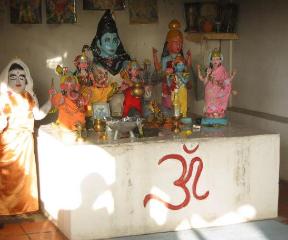
Birds sighted at Asa Wright:
|

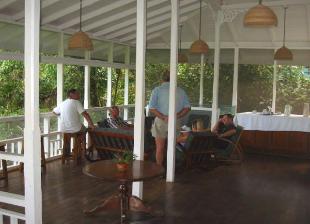
Shown here is the parlour of this wonderful old
house originally built in 1908.
house originally built in 1908.
| The huge verandah was the most popular meeting spot for relaxation, chatting, drinks and observing the wildlife. Very civilized! |
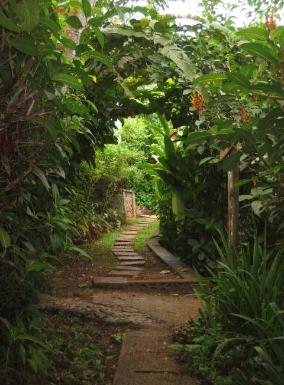
| There were several trails for walks and hikes including interpretive tours by center rangers. |
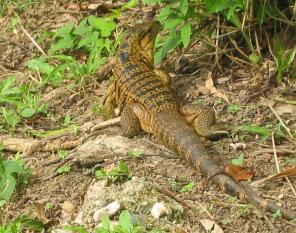
| We saw more than birds, however. Above, is a local lizard, about 3 feet long, called a matte. We also saw agouti, land crabs, bats and frogs. Two snakes which live in Trinidad, the fer de lance and the bushmaster, are lethal and considered among the most poisonous snakes in the world. Though they are “residents” of the nature center, we didn’t see them. (Tank de Lord!). |
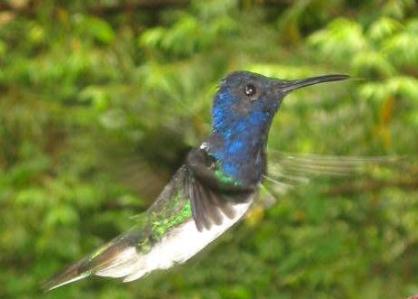
| Voted best picture taken on the trip...a jacobin viewed at 0600 from the verandah. He was sipping nectar while I was sipping tea. |
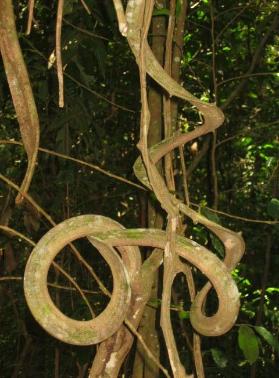
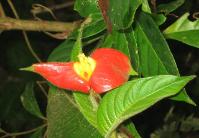
| The end of a passage. We left Charleston, SC on 17 January 2002 and arrived in Chaguaramas, Trinidad, West Indies on 30 July 2002. We logged 2,652 nautical miles and visited 17 countries. Time for some needed maintenance and repairs on Nine of Cups. Time to relax in a marina with land power which means air conditioning, as many lights as we want and unlimited CD and radio playing, unlimited water, dockside laundry…a myriad of amenities. This also means no sea breezes and boats so tight together, it’s closer to step onto your neighbor’s boat than onto the wharf. Where to next? First, a month long trip to the States to visit friends and relatives and meet our new granddaughter born in March. Then once all scheduled repairs and upgrades are complete (hopefully by the end of September), we’ll head out to Venezuela. Nine of Cups is now our “home”. We can wander through her at night with the lights off and not even stub our toes any more! She’s sea kindly and seaworthy and a most demanding mistress. We can’t seem imagine any other way of life. |
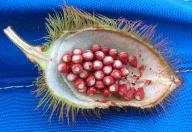
| Hot lips! |
| We also saw lots of interesting plants on our many walks including this monkey ladder. |
| Riccou |
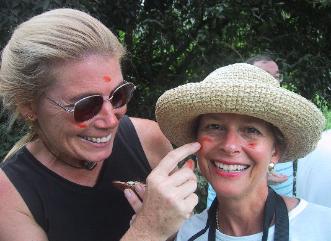
| Marcie and good friend, Laura (Windswept II) try the rouging effect of riccou which the locals use to color lips and cheeks. |
| We stayed in Trinidad until October 2002 and then headed for Venezuela. Come along with us if you can for our first introduction to South America. |